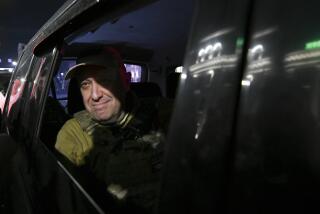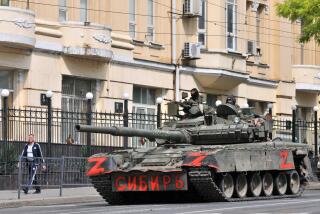Two Sentries at a Crossroads for Russia
- Share via
MOSCOW — If there was one moment that decided the outcome of the August coup--and, by extension, the fate of Russia--it was when Boris Yeltsin looked into Boris Tesyolkin’s eyes.
Tesyolkin was commander of a group of three tanks that pulled up outside Russian government headquarters on Aug. 19, 1991. And it was onto his tank that Yeltsin clambered to read his appeal declaring the putsch illegal and the putschists criminals.
For the record:
12:00 a.m. Aug. 24, 2001 FOR THE RECORD
Los Angeles Times Friday August 24, 2001 Home Edition Part A Part A Page 2 A2 Desk 2 inches; 42 words Type of Material: Correction
Soviet coup--A story Sunday incorrectly reported the recent employment history of two Russian army officers. Until last year, Sergei Yevdokimov worked as a draft officer in a northern district of Moscow. Boris Tesyolkin works in the mobilization department of the Russian army’s General Staff.
“I greeted the commander of the tank upon which I was standing and talked with the soldiers,” Yeltsin wrote later. “From their faces, from the expression in their eyes, I could see they would not shoot us.”
Yeltsin describes the moment as an epiphany. After meeting the tank crew, he wrote later, he was sure the Russian people--and the Russian army--would rally behind him.
It was his signature moment, the image that would define his career.
But according to Tesyolkin, Yeltsin misread the moment.
“He asked me, ‘Have you come to kill Yeltsin?’ ” Tesyolkin recalled in an interview. “I replied, ‘No.’ ”
That wasn’t an expression of support, Tesyolkin says--it was no more, and no less, than the truth. His tanks had no ammunition, and he had no orders to target Yeltsin. “I never supported Yeltsin,” he insists.
Amid the confusion that marked the coup, one concern dominated: Whom did the military support? The answer now, as then, isn’t completely clear.
After the coup, some news reports, including some in this newspaper, described Tesyolkin as rallying to Yeltsin’s defense. The fact that Tesyolkin’s tank was parked outside Yeltsin’s headquarters, a marble tower known as the White House, was interpreted as a sign that Tesyolkin and his company were on the Russian president’s side against the plotters.
But Tesyolkin tells a different story.
He was a 27-year-old captain in the elite Taman motor rifle division when he was roused from his bed at 2 a.m. at the division’s base 30 miles outside Moscow. He was told they’d been put on alert and he should prepare his company. He assumed it was a drill. At 5 a.m., they pulled out of the gates of the base. Tesyolkin still thought it was a drill. At 8 a.m., he was ordered to drive to Moscow and block traffic on a bridge next to the White House.
“We fulfilled the order we were given,” Tesyolkin says. “Although, to be honest, we never thought we’d go all the way to Moscow.”
The Taman division sent in about 40 tanks that day, divided into three companies. When they reached the bridge, the first two companies crossed and turned left down the embankment, rolling past the front of the White House.
Suddenly, he says, ordinary Russians started to walk up to the tanks. Some lay down in their path. Tesyolkin ordered his tanks to halt. Immediately, a few people climbed onto his tank. Tesyolkin’s mechanic had been riding with the hatch open, and they began to beat him on the head. Tesyolkin ordered the hatch closed.
“All of a sudden, there was a roar from the stairs--’Yeltsin! Yeltsin!’ And there was Yeltsin, coming down the stairs,” Tesyolkin recalls. “He came up to us, climbed up, showed no fear. He deserves credit for that. No one knew we didn’t have ammunition. For all he knew, he could have climbed up on the tank and been fired on. His bulletproof vest couldn’t have saved him, and he had nothing else. What he did was brave.”
Yeltsin Made Appeal
After his brief exchange with Yeltsin, Tesyolkin listened to the Russian president’s appeal along with everybody else.
“When I’d heard a little of what he said, I began to make sense of the situation,” Tesyolkin recalls. That morning, all he’d been told was that the tank crews were being sent into the capital because of a possibility of “disorder,” he says. “I began to think about it a little. . . . This could have turned serious. But no one can attack their own people. I know I couldn’t, and I couldn’t order my subordinates to.”
But he never faced that decision. When Yeltsin finished, he asked the crowd to let the tanks pull away. The crowd backed away, and the tanks drove off to fulfill their orders to blockade a second bridge about three miles farther along the river.
“I was just a captain. I wasn’t even 30 years old. None of it was really sinking in,” Tesyolkin says now. “All we did was follow orders.”
Back at the White House, another commander, Sergei Yevdokimov, was also trying to make sense of the situation.
Yevdokimov, a 36-year-old major, had been left in charge of the one tank company still stationed outside the White House. He hadn’t heard Yeltsin’s speech, and he knew nothing other than his orders--block the bridge.
He lined up his 10 tanks--four on the far side of the bridge, six on the White House side. It was noon. He waited for new orders. None came.
Meanwhile, several hundred people started crowding around. They shoved sheets of paper into his hands--copies of Yeltsin’s speech.
“When we got the photocopies and started talking to the people, I began to understand basically what was happening--who was right, who was wrong,” Yevdokimov recalls.
Yevdokimov wondered whether he should try to separate his troops from the crowd, but he remembered a Soviet slogan--The Army and the People Are One--and figured there was no point. He watched as the crowd assembled crude barricades.
In the late afternoon, a lawmaker with the rank of colonel came out of the White House in uniform and invited Yevdokimov inside for talks. He was ushered in to see Yeltsin’s vice president, Alexander Rutskoi.
“I don’t remember his exact words, but there was a key sentence along the lines of, ‘But you understand, don’t you, that [the coup plotters] are criminals?’ ” Yevdokimov recalls. “I said, ‘Yes, I do. Basically, I’m already on your side.’ ” And together they drew up a plan for where to place Yevdokimov’s tanks around the White House.
“At a minimum, I thought I’d be thrown out of the army. Maybe they’d put me in jail. I was worried only for my family,” Yevdokimov says. “But Stalin’s times were already long past.”
It was already night on the 19th. Yevdokimov ordered the six tanks nearest the White House to take up positions on its grounds, swiveling their barrels in its defense.
They had no ammunition; it remained in several trucks parked inconspicuously along the river.
“They were just standing there as decoration,” recalls military analyst Pavel Felgenhauer, who was inside the White House at the time.
Yevdokimov’s tanks sat there through the night and the following day. The crowd organized itself into human “chains” around the building to try to deter an expected assault.
On the evening of the 20th, the commander of Yevdokimov’s regiment showed up in a jeep and asked him to come out. He ferried Yevdokimov to various military offices through the night, with the regiment commander and other higher-ups suggesting that Yevdokimov repudiate his move. But they never pressed the issue, apparently playing a wait-and-see game. He spent the night sleeping in a car.
“The military began to improvise as soon as it was clear that something was going wrong,” Felgenhauer said.
By the next evening, the coup had crumbled and Yevdokimov’s superiors were saying they’d been on Yeltsin’s side all along. The regiment commander was breaking out champagne and drinking “to victory.” Two days later, Yevdokimov says, the regiment commander took him aside and said, “If they ask, say I was the one who ordered the tanks to stand around the White House.”
Post-Coup Paths
The 10 years since the coup was foiled have not been easy on either man.
Yevdokimov, who had violated orders, found himself in an awkward position after the coup. He was called to testify when the coup plotters went on trial, and his testimony contradicted that of his superiors. His bosses warned him to fall in line or risk the consequences.
He went to Rutskoi and asked for a transfer. Until last year, he worked in the recruiting department of a different tank division. And when he reached early retirement age last year, he left the army. He’s now looking for work.
“You could say I’m on a creative quest,” he says.
Tesyolkin, who had followed orders, found himself in a field on a collective farm a month after the coup, pulling cabbage from the earth. It was part of the Soviet practice of sending out soldiers to help bring in the harvest.
He never met Yeltsin again.
“I never broadcast what I did,” he says. “I didn’t care to.”
He still serves in the Taman tank division, these days as a recruitment officer with the rank of lieutenant colonel. He lives in a rundown communal apartment 40 miles outside Moscow with his wife and two children. He has voted for the Communists in every post-Soviet presidential election.
“I am a child of the old school, and my views have not really changed,” he says. “I understand now that it all could have been done differently. And what followed over the next 10 years, in particular the collapse of the Soviet Union--I did not support it then, and I do not support it now.”
More to Read
Sign up for Essential California
The most important California stories and recommendations in your inbox every morning.
You may occasionally receive promotional content from the Los Angeles Times.













